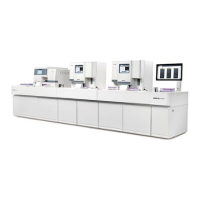Servicing Your System
8-3
8.3 Replacing
8.3.1 When, Why and Tools Needed
Replacing reagent container
Replacing waste container
When the waste container is
full.
8.3.2 Replacing Reagent Container or Waste Container
All the samples, controls, calibrators, reagents, wastes and areas contacted
by them are potentially biohazardous. Wear proper personal protective
equipment (e.g. gloves, lab coat, etc.) and follow safe laboratory procedures
when handling them in the laboratory.
WARNING
Be sure to dispose of reagents, waste, samples, consumables, etc.
according to government regulations.
If reagents accidentally spill on your skin or in your eyes, rinse the area with
ample amount of clean water; seek medical attention immediately.
Remove the waste container cap and replace the waste container only when
the power indicator is not flickering, in order not to make the waste overflow
from the container.
CAUTION
After replacing the reagent container, check the tubing connected to the cap
assembly and make sure it is not bent over.
After the instruments are connected into the auto sample processing line by CAL 8000, the
reagent containers (except the fluorescent reagents of the analyzer) and the waste
containers are placed in the cabinet of the corresponding track module.
Press the sunken area near the top of the cabinet door, and the door will open
outwards,

